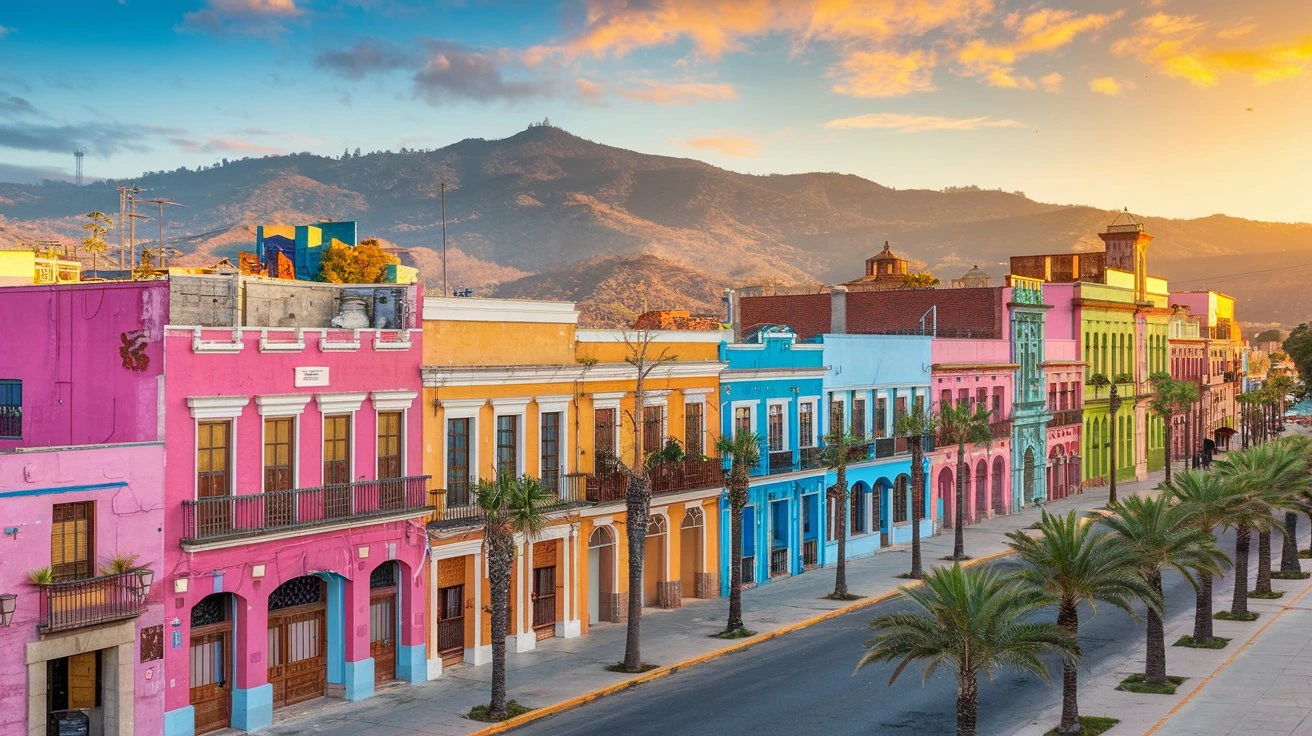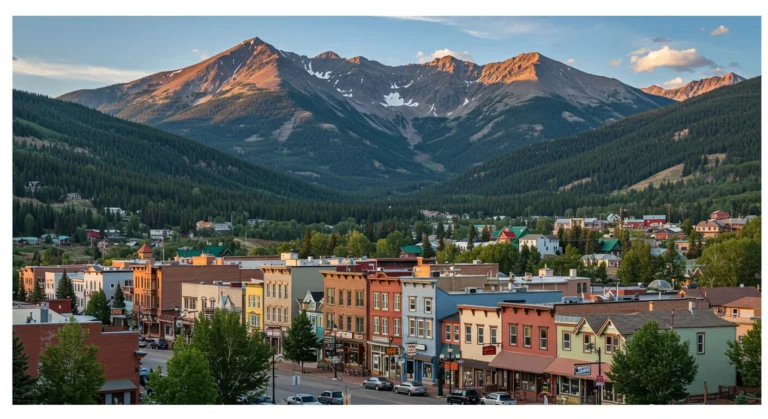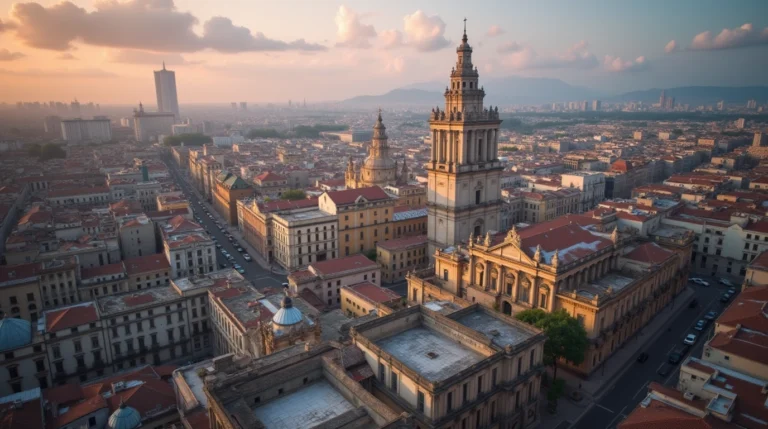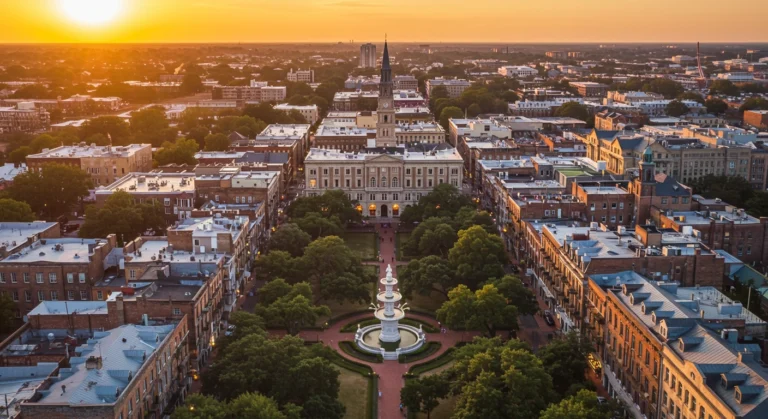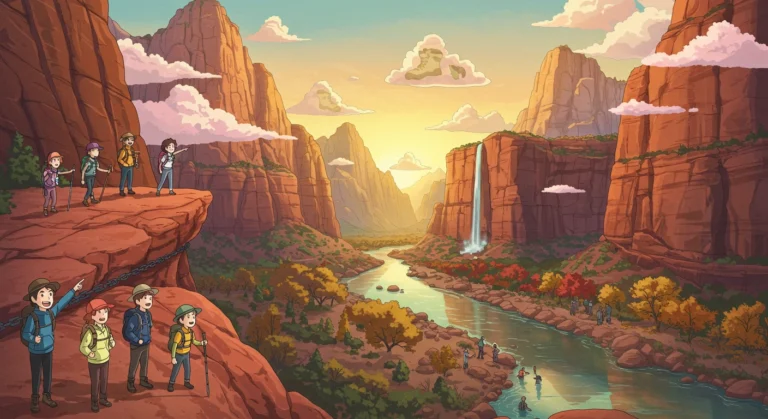best places to visit in mexico
Table of Contents
Introduction : 10 Best Places to Visit in Mexico
Hey there, fellow wanderluster! Dreaming of swaying palm trees, ancient ruins, mouthwatering tacos, and crystal-clear waters? Mexico has been calling my name for years, and after multiple trips exploring this vibrant country, I’m ready to spill the beans on the absolute best places you need to visit. From bustling colonial cities to laid-back beach towns, let me take you on a virtual tour of Mexico’s most incredible destinations!

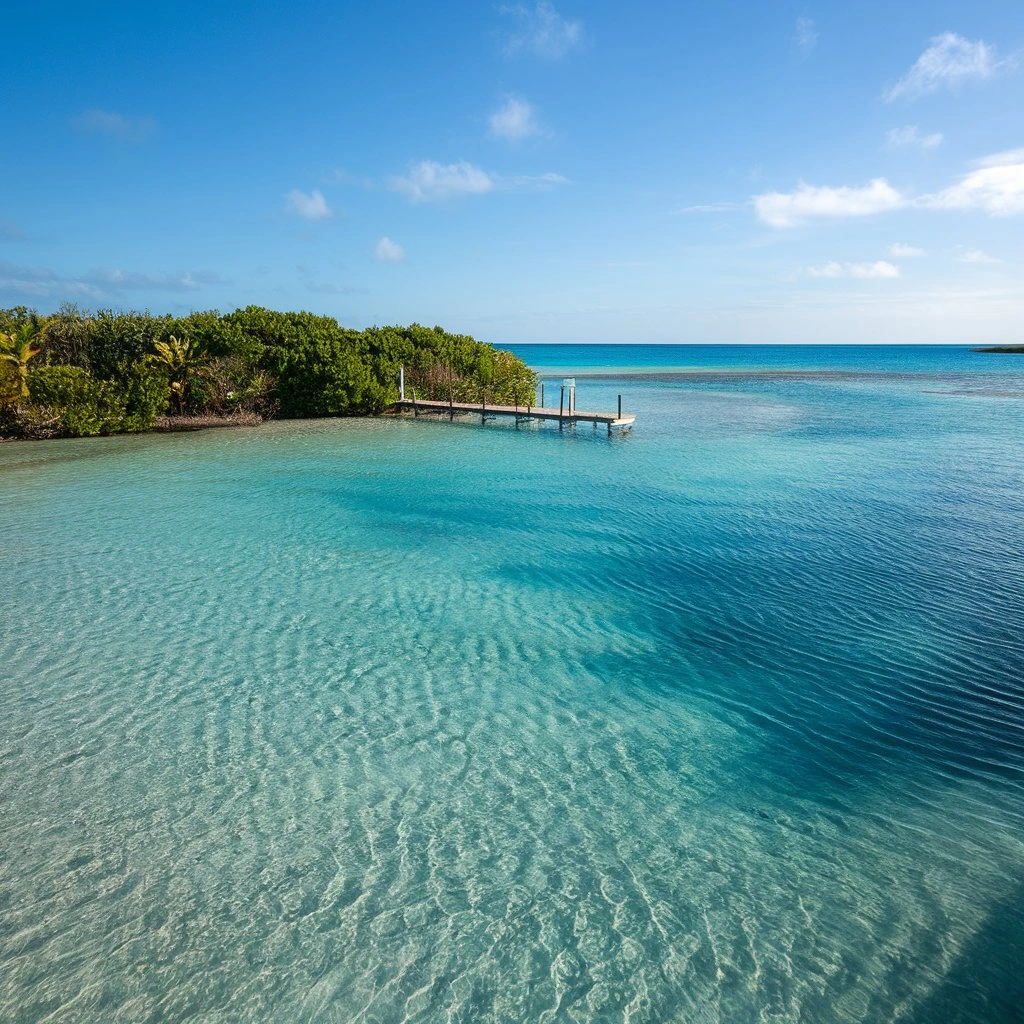
Tulum: Where Jungle Meets Caribbean Paradise
Ever seen those Instagram-worthy photos of ancient Mayan ruins perched on a cliff overlooking turquoise waters? That’s Tulum for you—a place that somehow manages to combine history, natural beauty, and bohemian vibes into one irresistible package.
The archaeological site is obviously the star attraction, but what really makes Tulum special is the overall atmosphere. I spent a week cruising around on a rental bike, alternating between exploring cenotes (natural swimming holes formed by collapsed limestone), lounging on powder-white beaches, and indulging in fresh seafood tacos from roadside stands.
The town has exploded in popularity in recent years, bringing with it chic boutique hotels, yoga retreats, and farm-to-table restaurants hidden in the jungle. Yes, it’s more expensive than other parts of Mexico, but waking up to the sound of tropical birds and falling asleep to ocean breezes makes it worth every peso.
Pro tip: Visit the ruins right when they open to avoid both crowds and the scorching midday heat. Your photos (and comfort level) will thank you!
Mexico City: A Cultural Powerhouse
I’ll admit it—I initially avoided Mexico City because of its reputation for being overwhelming and chaotic. Boy, was that a mistake! This sprawling metropolis completely shattered my expectations and quickly became one of my favorite cities worldwide.
CDMX (as the locals call it) packs enough museums, historical sites, parks, and restaurants to keep you busy for months. The historic center features stunning colonial architecture surrounding the massive Zócalo plaza, while neighborhoods like Roma and Condesa offer tree-lined streets filled with hip cafes, colorful street art, and beautiful Art Deco buildings.
Food lovers, prepare to be in absolute heaven. From high-end restaurants like Pujol to humble street food stands selling life-changing tacos al pastor for less than a dollar, the culinary scene is unmatched. I still dream about the tlacoyos I devoured at a tiny market stall run by an elderly woman who had been making them for over 40 years.
Wondering about safety? Like any major city, common sense goes a long way. I found Mexico City to feel safer than many American cities I’ve visited, particularly in the main tourist areas and residential neighborhoods.
San Miguel de Allende: Colonial Charm Perfected
If fairytale towns exist, San Miguel de Allende is definitely one of them. This UNESCO World Heritage site in central Mexico features cobblestone streets lined with perfectly preserved Spanish colonial buildings painted in warm shades of orange, yellow, and red.
The heart of town is the Parroquia de San Miguel Arcángel, a pink neo-Gothic church that looks like it was plucked straight from a European storybook. The surrounding plaza buzzes with activity day and night, filled with mariachi bands, food vendors, and locals enjoying the perpetually perfect weather.
What makes San Miguel truly special is its thriving arts scene. The town has attracted creative types for decades, resulting in countless galleries, art schools, and workshops. I took a one-day silversmithing class and left with both a handmade ring and a newfound appreciation for Mexican craftsmanship.
The expat influence means you’ll find plenty of English speakers and international restaurants, but the town remains authentically Mexican at its core. FYI, the hills can be brutal on your calves, so pack comfortable shoes and prepare for a workout!
Oaxaca City: Mexico’s Culinary Capital
If you consider yourself a foodie and haven’t visited Oaxaca yet, you’re seriously missing out. This southern Mexican city is widely considered the country’s gastronomic heartland, famous for its seven styles of mole sauce, tlayudas (often called “Mexican pizza”), and mezcal production.
Beyond the food, Oaxaca captivates visitors with its rich indigenous heritage. The surrounding valleys house ancient Zapotec ruins, traditional weaving villages, and artisan workshops where you can watch masters create intricate alebrijes (colorful folk art sculptures).
The city itself centers around a gorgeous colonial core, with the Santo Domingo church and adjacent botanical garden being particular highlights. Markets like 20 de Noviembre and Benito Juárez offer sensory overload in the best possible way—the smells, sounds, and colors create an experience you won’t soon forget.
I spent mornings sipping incredible local coffee in quiet courtyards, afternoons exploring museums and churches, and evenings sampling mezcal varieties I never knew existed. The result? One of the most authentic and rewarding travel experiences of my life.
Puerto Vallarta: Where Mountains Meet the Sea
Puerto Vallarta offers the perfect combination of natural beauty, adventure, and comfort. Nestled where the Sierra Madre mountains meet Banderas Bay, this Pacific coast destination provides a stunning backdrop for every vacation photo.
The Malecón (oceanfront promenade) buzzes with energy day and night, lined with restaurants, bars, and impressive sand sculptures and public art installations. Just a short walk away, the Zona Romántica charms visitors with its narrow cobblestone streets, boutique hotels, and vibrant LGBTQ+ scene.
What sets Puerto Vallarta apart from other beach destinations is the sheer variety of activities available. One day I found myself hiking through jungle trails to discover hidden waterfalls, and the next I was sipping margaritas on a sunset sailing cruise watching humpback whales breach in the distance.
The food scene rivals major cities, with everything from beachfront taco stands to world-class restaurants helmed by celebrity chefs. My absolute favorite meal? Fresh red snapper grilled whole Zarandeado-style at a tiny restaurant on the beach south of town. Simple, perfect, and impossible to replicate back home.
Guanajuato: The Most Colorful City You’ll Ever See
Picture a city where rainbow-colored buildings cascade down hillsides, where most streets are actually underground tunnels, and where narrow alleyways lead to hidden plazas filled with music and laughter. That’s Guanajuato—a place that feels more like a movie set than reality.
This university town and former silver mining hub offers a uniquely pedestrian-friendly experience. The historic center is largely car-free, with a network of underground tunnels (repurposed from old riverbed and mining shafts) handling most vehicle traffic. This creates a magically peaceful atmosphere above ground.
The city’s most famous alley, Callejón del Beso (Alley of the Kiss), is so narrow that balconies nearly touch—legend says lovers who kiss on the third step will enjoy seven years of happiness. Cheesy? Absolutely. Did I make my travel buddy stand there to take photos anyway? You bet I did. 🙂
For panoramic views that will blow your mind, take the funicular up to the Pipila Monument. The vista of colorful buildings, baroque churches, and surrounding mountains made me audibly gasp the first time I saw it.
Bacalar: The Lagoon of Seven Colors
If you’re looking for Mexico’s next big destination before the crowds discover it, head to Bacalar in the southern part of Quintana Roo. This sleepy lakeside town centers around a stunning freshwater lagoon nicknamed “The Lagoon of Seven Colors” due to its incredible spectrum of blue hues.
Unlike the nearby Caribbean coast, Bacalar offers a completely different water experience. The lagoon is crystal clear and shallow in many areas, with a sandy bottom that creates the most extraordinary shades of blue I’ve ever seen. Several cenotes feed into the lagoon, creating “black holes” where the water suddenly drops to impressive depths.
Activities revolve around the water—sailing, kayaking, paddleboarding, or simply floating in the gentle current of the Pirate Channel. The famous stromatolites (some of the oldest living organisms on earth) create rock-like formations in parts of the lagoon and are incredibly fragile ecosystems, so responsible tourism is essential here.
I spent three days in a hammock cabin right on the water’s edge, waking up to spectacular sunrises and falling asleep to the gentle lapping of water. It was the perfect digital detox and a reminder of what Mexico looked like before mass tourism arrived.
Mérida: The Cultural Heart of the Yucatán
The capital of Yucatán state doesn’t always make it onto first-time visitors’ itineraries, which is a shame because Mérida offers one of the most authentic cultural experiences in the region. This elegant city showcases the unique blend of Maya and Spanish colonial influences that define Yucatecan culture.
The historic center features imposing mansions built during the henequen (sisal) boom of the late 19th century, many of which have been converted into museums, boutique hotels, and restaurants. Paseo de Montejo, often called the “Champs-Élysées of Mexico,” provides a grand boulevard perfect for evening strolls.
What truly won me over was the vibrant local culture. Mérida hosts free cultural events nearly every night of the week—traditional dance performances in the main plaza, live music in the parks, and video mappings projected onto historic buildings. This commitment to preserving and celebrating Yucatecan culture creates a wonderfully immersive experience.
The food deserves special mention—Yucatecan cuisine stands apart from what most people consider “Mexican food” with its unique ingredients and preparation methods. Don’t leave without trying cochinita pibil (slow-roasted pork marinated in achiote and sour orange) and papadzules (corn tortillas filled with hard-boiled eggs in a pumpkin seed sauce).
Copper Canyon: Mexico’s Grand Canyon on Steroids
Most travelers don’t realize that Mexico has a canyon system four times larger and in places deeper than the Grand Canyon! The Copper Canyon (Barrancas del Cobre) in Chihuahua state offers some of North America’s most spectacular landscapes and remains relatively undiscovered by international tourists.
The best way to experience this natural wonder is aboard the Chepe Express train, which makes a 400-mile journey through the Sierra Madre mountains, crossing 37 bridges and passing through 86 tunnels. The engineering feat alone is impressive, but the views—oh my god, the views! Sheer canyon walls, plunging waterfalls, and pine forests stretch as far as the eye can see.
I spent three days hopping on and off the train at different stops, hiking to viewpoints, and staying in small towns perched on the canyon rim. The indigenous Rarámuri people have inhabited these canyons for centuries, maintaining their traditional way of life despite the challenging terrain.
This isn’t a luxury destination—accommodations and dining options are limited in most stops along the way. But for travelers seeking natural grandeur and cultural authenticity away from the typical tourist circuit, Copper Canyon delivers an experience that rivals any natural wonder in the world.
Isla Holbox: Barefoot Paradise
Last but definitely not least is tiny Isla Holbox, located at the tip of the Yucatán Peninsula where the Gulf of Mexico meets the Caribbean. This car-free island offers what Tulum provided twenty years ago—an unspoiled beach paradise with sandy streets, colorful murals, and a delightfully laidback vibe.
The island’s main draw is its natural beauty. Shallow, warm waters extend hundreds of yards offshore, creating perfect conditions for swimming, kiteboarding, and paddleboarding. From June to September, whale sharks gather in the surrounding waters, offering the incredible opportunity to snorkel alongside these gentle giants.
What Holbox lacks in infrastructure (expect occasional power outages and limited internet), it makes up for in charm. There are no large resorts, just small hotels and beach bungalows. Transportation consists of golf carts and bicycles. Restaurants serve fresh-caught seafood with your feet in the sand.
My favorite Holbox memory? Wading through warm, knee-deep water at Punta Cocos during sunset, watching the sky transform into impossible shades of pink and orange while bioluminescent plankton began to glow beneath the surface. Pure magic that no photo could ever capture.
Mexico offers such incredible diversity that choosing the “best” places ultimately depends on what you’re seeking—ancient history, culinary adventures, natural wonders, or simply a beautiful beach to relax on. The destinations I’ve shared represent my personal favorites after multiple trips, but they barely scratch the surface of what this amazing country has to offer.
One thing I’ve learned from my travels through Mexico is to approach each place with an open mind and a willingness to embrace the unexpected. Some of my most memorable experiences came from random conversations with locals, impromptu detours, and restaurants with no English menus.
So pack your sense of adventure (and appetite!), brush up on basic Spanish phrases, and prepare to fall in love with Mexico. Trust me, one visit will never be enough—this country has a way of calling you back again and again.
What part of Mexico are you most excited to explore? ¡Buen viaje!

